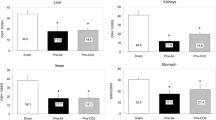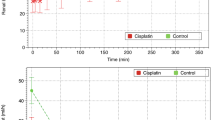Abstract
Background
Physiologic renal changes associated with pneumoperitoneum (PNP) have been described and various underlying mechanisms have been suggested. We investigated the possibility that PNP-associated renal damage is pressure dependent, and that oxidative stress is thereby involved.
Materials and methods
Seventy Wistar rat kidneys (n = 10 per group) were isolated. They were perfused with oxygenated, warm, Krebs–Henseleit solution containing 5% albumin within an isolated environment and subjected to various CO2 pressures (0 [control], 3, 5, 8, 12, 15, and 18 mmHg) for 60 min. Half of each group was additionally perfused for 30 min at 0 mmHg pressure.
Results
Renal flow decreased proportionately to the applied pressure as did urine output: both decreased (P < 0.05) after 60 and 90 min when pressure ≥8 mmHg was applied. Oxygen extraction decreased (P < 0.05) during PNP in all pressurized groups. Xanthine oxidase (XO) activity and reduced glutathione in the tissues increased (P < 0.05) proportionately to pressures ≥8 mmHg. All parameters slightly reversed toward baseline values, upon the release of the intra-chamber pressure, except for the 18 mmHg group’s values.
Conclusions
CO2-PNP pressure induces kidney injury, possibly reversible immediately after pressure is annulled. Pressure is associated with oxidative stress, which interferes with cellular metabolism and function, possibly via an ischemic-reperfusion-like mechanism.




Similar content being viewed by others
References
Schachtrupp A, Toens Ch, Hoer J, Klosterhalfen B, Lawong AG, Schumpelick V (2002) A 24-h pneumoperitoneum leads to multiple organ impairment in a porcine model. J Surg Res 106:37–45
Hazebroek EJ, de Bruin RW, Bouvy ND, Marquet RL, Bonthuis F, Bajema IM, Hayes DP, Ijzermans JN, Bonjer HJ (2003) Long-term impact of pneumoperitoneum used for laparoscopic donor nephrectomy on renal function and histomorphology in donor and recipient rats. Ann Surg 237:351–357
Horvath KD, Whelan RL, Lier B, Viscomi S, Barry L, Buck K, Bessler M (1998) The effects of elevated intraabdominal pressure, hypercarbia, and positioning on the hemodynamic responses to laparoscopic colectomy in pigs. Surg Endosc 12:107–114
Koivusalo AM, Kellokumpu I, Scheinin M, Tikkanen I, Halme L, Lindgren L (1996) Randomized comparison of the neuroendocrine response to laparoscopic cholecystectomy using either conventional or abdominal wall lift techniques. Br J Surg 83:1532–1536
Pérez J, Taurá P, Rueda J, Balust J, Anglada T, Beltran J, Lacy AM, Garcia-Valdecasas JC (2002) Role of dopamine in renal dysfunction during laparoscopic surgery. Surg Endosc 16:1297–1301
McDougall EM, Monk TG, Wolf JS Jr, Hicks M, Clayman RV, Gardner S, Humphrey PA, Sharp T, Martin K (1996) The effect of prolonged pneumoperitoneum on renal function in an animal model. J Am Coll Surg 182:317–328
Kirsch AJ, Hensle TW, Chang DT, Kayton ML, Olsson CA, Sawczuk IS (1994) Renal effects of CO2 insufflation: oliguria and acute renal dysfunction in a rat pneumoperitoneum model. Urology 43:453–459
Ortega AE, Peters JH, Incarbone R, Estrada L, Ehsan A, Kwan Y, Spencer CJ, Moore-Jeffries E, Kuchta K, Nicoloff JT (1996) A prospective randomized comparison of the metabolic and stress hormonal responses of laparoscopic and open cholecystectomy. J Am Coll Surg 183:249–256
Hazebroek EJ, de Vos tot Nederveen Cappel R, Gommers D, van Gelder T, Weimar W, Steyerberg EW, Bonjer HJ, IJzermans JN (2002) Antidiuretic hormone release during laparoscopic donor nephrectomy. Arch Surg 137:600–604; discussion 605
Price HL (1960) Effects of carbon dioxide on the cardiovascular system. Anesthesiology 21:652–663
Koivusalo AM, Scheinin M, Tikkanen I, Yli-Suomu T, Ristkari S, Laakso J, Lindgren L (1998) Effects of esmolol on haemodynamic response to CO2 pneumoperitoneum for laparoscopic surgery. Acta Anaesthesiol Scand 42:510–517
Micali S, Silver RI, Kaufman HS, Douglas VD, Marley GM, Partin AW, Moore RG, Kavoussi LR, Docimo SG (1999) Measurement of urinary N-acetyl-beta-D-glucosaminidase to assess renal ischemia during laparoscopic operations. Surg Endosc 13:503–506
London ET, Ho HS, Neuhaus AM, Wolfe BM, Rudich SM, Perez RV (2000) Effect of intravascular volume expansion on renal function during prolonged CO2 pneumoperitoneum. Ann Surg 231:195–201
Nogueira JM, Cangro CB, Fink JC, Schweitzer E, Wiland A, Klassen DK, Gardner J, Flowers J, Jacobs S, Cho E, Philosophe B, Bartlett ST, Weir MR (1999) A comparison of recipient renal outcomes with laparoscopic versus open live donor nephrectomy. Transplantation 67:722–728
Flowers JL, Jacobs S, Cho E, Morton A, Rosenberger WF, Evans D, Imbembo AL, Bartlett ST (1997) Comparison of open and laparoscopic live donor nephrectomy. Ann Surg 226:483–9 discussion 489–490
Eleftheriadis E, Kotzampassi K, Papanotas K, Heliadis N, Sarris K (1996) Gut ischemia, oxidative stress, and bacterial translocation in elevated abdominal pressure in rats. World J Surg 20:11–16
Hashimoto S (1974) A new spectrophotometric assay method of xanthine oxidase in crude tissue homogenate. Anal Biochem 62:426–435
Parks DA, Williams TK, Beckman JS (1998) Conversion of xanthine dehydrogenase to oxidase in ischemic rat intestine: a reevaluation. Am J Physiol 254:768–774
Tan S, Yokoyama Y, Dickens E, Cash TG, Freeman BA, Parks DA (1993) Xanthine oxidase activity in the circulation of rats following hemorrhagic shock. Free Radic Biol Med 15:407–414
Aranda R, Doménech E, Rus AD, Real JT, Sastre J, Viña J, Pallardó FV (2007) Age-related increase in xanthine oxidase activity in human plasma and rat tissues. Free Radic Res Sep 28:1–6 [Epub ahead of print]
Cotgreave IA, Grafström RC, Moldeus P (1986) Modulation of pneumotoxicity by cellular glutathione and precursors. Bill Rur Physiopathol Respir 22:263s–266s
Jain A, Martensson J, Stole E, Auld PA, Meister A (1991) Glutathione deficiency leads to mitochondrial damage in brain. Proc Natl Acad Sci USA 88:1913–1917
Weinbroum A, Nielsen VG, Gelman S, Tan S, Matalon S, Skinner KA, Bradley E Jr, Parks DA (1995) Liver ischemia-reperfusion increases pulmonary permeability in rat: role of circulating xanthine oxidase. Am J Physiol 268(6 Pt 1):G988–G996
Gelman S (1995) The pathophysiology of aortic cross-clamping and unclamping. Anesthesiology 82:1026–1060
Szold A, Weinbroum AA (2008) Carbon dioxide pneumoperitoneum-related liver injury is pressure dependent: a study in an isolated-perfused organ model. Surg Endosc 22:365–371
Nakache R, Rudick V, Fiodorov D, Klausner JM, Almogy N, Karckevski E, Weinbroum AA (1999) Cumulative damaging effect of liver hypoperfusion and cyclosporine A on the peribiliary capillary plexus: a study in an isolated dually perfused rat model. Transplantation 68:1651–1660
Nakache R, Isretil I, Ekstein P, Almogy N, Fedorov D, Lifschitz-Mercer B, Weinbroum AA (2007) Nontoxic effect of tacrolimus on normally perfused isolated liver and protective effect on hypoperfused liver. Med Sci Monit 13:BR32–BR39
Weinbroum AA, Hochhauser E, Rudick V, Kluger Y, Karchevsky E, Vidne BA (1999) Multiple organ dysfunction following remote circulatory arrest: common pathway of radical oxygen species? J Trauma 47:691–698
Friedl HP, Smith DJ, Till GO, Thomson PD, Louis DS, Ward PA (1990) Ischemia-reperfusion in humans. Appearance of xanthine oxidase activity. Am J Pathol 136:491–495
Nielsen VG, Weinbroum A, Tan S, Samuelson PN, Gelman S, Parks DA (1994) Xanthine oxidoreductase release after descending thoracic aorta occlusion and reperfusion in rabbits. J Thorac Cardiovasc Surg 107:1222–1227
Nielsen VG, Tan S, Baird MS, McCammon AT, Parks DA (1996) Gastric intramucosal pH and multiple organ injury: impact of ischemia-reperfusion and xanthine oxidase. Crit Care Med 24:1339–1344
Nielsen VG, Tan S, Baird MS, Samuelson PN, McCammon AT, Parks DA (1997) Xanthine oxidase mediates myocardial injury after hepatoenteric ischemia-reperfusion. Crit Care Med 25:1044–1050
O’Leary AM, Veall G, Butler P, Anderson GH (1990) Acute pulmonary oedema after tourniquet release. Can J Anaesth 37:826–827
Tan S, Gelman S, Wheat JK, Parks DA (1995) Circulating xanthine oxidase in human ischemia reperfusion. South Med J 88:479–482
Weinbroum A, Goldman G, Hag M, Hazam A, Marmour S, Sorkine P, Rudick V, Klausner JM (1997) Bowel ischemia/reperfusion-induced liver and lung injury: role of eicosanoids and oxygen free radicals. Med Sci Monit 5:624–630
Weinbroum AA, Hochhauser E, Rudick V, Kluger Y, Sorkine P, Karchevsky E, Graf E, Boher P, Flaishon R, Fjodorov D, Niv D, Vidne BA (1997) Direct induction of acute lung and myocardial dysfunction by liver ischemia-reperfusion. J Trauma 43:627–635
Neglen P, Jabs CM, Eklof B (1989) Plasma metabolic disturbances and reperfusion injury following partial limb ischaemia in man. Eur J Vasc Surg 3:165–172
Huval WV, Lelcuk S, Allen PD, Mannick JA, Shepro D, Hechtman HB (1984) Determinants of cardiovascular stability during abdominal aortic aneurysmectomy (AAA). Ann Surg 199:216–222
Cross CE, Halliwell B, Borish ET, Pryor WA, Ames BN, Saul RL, McCord JM, Harman D (1987) Oxygen radicals and human disease [clinical conference]. Ann Intern Med 107:526–545
McCord JM (1985) Oxygen-derived free radicals in postischemic tissue injury. N Engl J Med 312:159–163
Koelzow H, Gedney JA, Baumann J, Snook NJ, Bellamy MC (2002) The effect of methylene blue on the hemodynamic changes during ischemia reperfusion injury in orthotopic liver transplantation. Anesth Analg 94:824–829
Giler S, Sperling O, Brosh S, Urca I, De Vries A (1975) Serum xanthine oxidase in jaundice. Clin Chim Acta 63:37–40
Weinbroum AA, Kluger Y, Rudick V (2000) Impairment of aortal tone by no flow-reflow conditions and its partial amelioration by mannitol. Ann Thorac Surg 69:1439–1444
Hazebroek EJ, de Bruin RW, Bouvy ND, van Duikeren S, Bonthuis F, Marquet RL, Bajema IM, Hayes DP, IJzermans JN, Bonjer HJ (2002) Short-term impact of carbon dioxide, helium, and gasless laparoscopic donor nephrectomy on renal function and histomorphology in donor and recipient. Surg Endosc 16:245–251
Lee BR, Cadeddu JA, Molnar-Nadasdy G, Enriquez D, Nadasdy T, Kavoussi LR, Ratner LE (1999) Chronic effect of pneumoperitoneum on renal histology. J Endourol 13:279–282
Avital S, Inbar R, Ben-Abraham R, Szomstein S, Rosenthal R, Sckornik Y, Weinbroum AA (2007) Effect of small bowel perforation during laparoscopy on end-tidal carbon dioxide: observation in a small animal model. J Surg Res 143:368–371
Blobner M, Bogdanski R, Kochs E, Henke J, Findeis A, Jelen-Esselborn S (1998) Effects of intraabdominally insufflated carbon dioxide and elevated intraabdominal pressure on splanchnic circulation: an experimental study in pigs. Anesthesiology 89:475–482
Author information
Authors and Affiliations
Corresponding author
Additional information
This paper was presented in part in the 15th EAES, July 2007, Athens, Greece.
Rights and permissions
About this article
Cite this article
Khoury, W., Schreiber, L., Szold, A. et al. Renal oxidative stress following CO2 pneumoperitoneum-like conditions. Surg Endosc 23, 776–782 (2009). https://doi.org/10.1007/s00464-008-0054-2
Received:
Revised:
Accepted:
Published:
Issue Date:
DOI: https://doi.org/10.1007/s00464-008-0054-2




